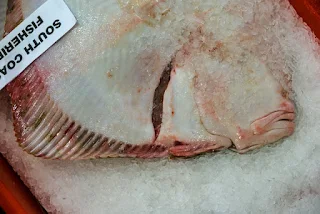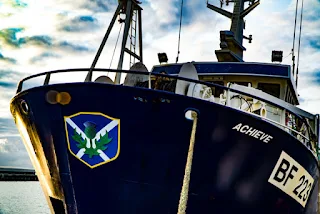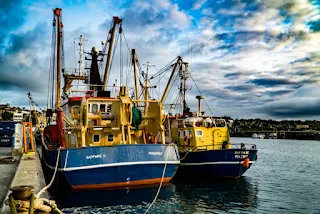BRITAIN ON FILM The British Film Institute presents the BFI National Archive.
Falmouth Scallop Dredgers 1978 South West Film and Television Archive
Click on the image to see the film. What the accompanying text doesn't explain is exactly what is happening in the film clip. A few of the inshore scallopers that worked in Falmouth Bay in the 70s are seen returning to port with their scallop dredges full - but close up shots of the dredges reveal they are full of dead mackerel - not scallops. This was a common occurrence for inshore trawlers during the winter months in both Falmouth and Mount's Bay when dozens of East coast freezer trawlers and Scottish pursers lost huge catches of mackerel for various reasons.
| Tons of rotting mackerel on the deck of the trawler Girl Freda, skipper Bobby Cairns taken while fishing in Mount's Bay, winter 1979. |
The Marine Conservation Society encourages the use of hand diving for fresh scallops and shellfish whereas fishermen fear less commercial methods would impact on jobs in the sector. The dredging itself is non-selective and consists of a heavy metal frame with spring-loaded teeth attached to a metal mesh net being pulled along the sea bed. Bottom-dwelling species such as scallops, oysters, clams and crabs are collected but the sea bed is damaged and takes years to recover. Ed note - currently, hand-dived scallops represent less than 10% of the scallops landed.
The practice is regulated as a local coastal fishery by the Salmon & Freshwater Fisheries Act of 1975 and the Cornwall Sea Fisheries Committee operates up to 6 nautical miles offshore from Falmouth and beyond the 6-mile coastal fishery the MFA operate. The Cornwall River Board & Sea Fisheries Byelaws of 1896, the Sea Fisheries Regulation Act of 1966 and SAFFA all apply to the Falmouth coastal fishery. The laws include no fixed nets, no trawling, no scallop dredging and a minimum length 37.5cm for sea bass. The Common Fisheries’ Policy or CFP regulates fishing in the EU and has done much to make fishing sustainable following the collapse of certain fisheries.
The South West Film and Television Archive (SWFTA) is the regional film archive for the South West of England. Established in 1993, SWFTA's core collection comprises of the combined programme libraries of Westward Television and TSW (Television South West). The archive also cares for a significant number of donated film collections, both amateur and professional, dating back to the early 1900s.
















































